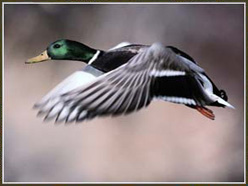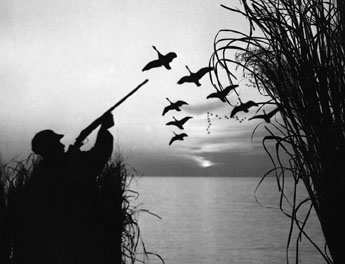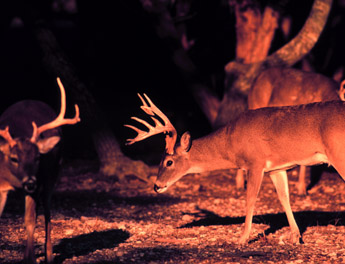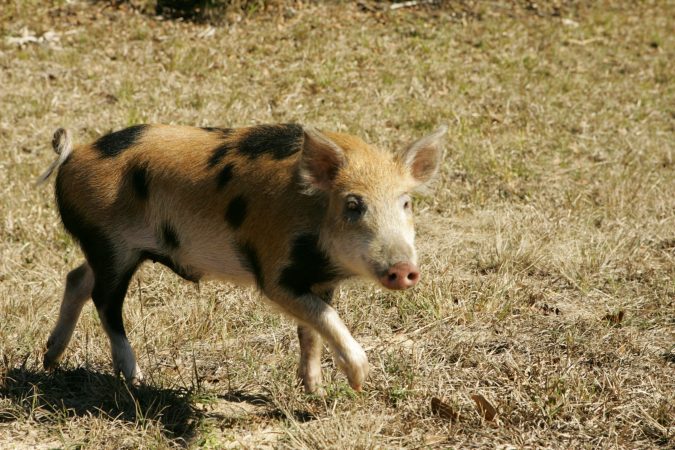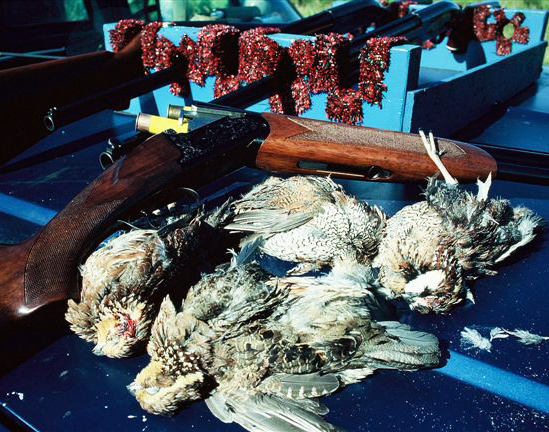LBJ Grasslands Waterfowl
Thousands of acres of prime duck territory
Texas The ponds and small lakes on the Caddo-LBJ National Grasslands north of Decatur turn the color of ducks in December and January. The LBJ is 20,000 acres of diverse habitat divided among several dozen scattered parcels. Lakes up to 20 acres sport good shoreline cover and shallow vegetation. Waterfowl from teal to resident mallards and an occasional goose gaggle show up, especially late in the season.
The smartest way to hunt on the ponds and smaller lakes at LBJ is to erect portable or impromptu blinds on the shore. But you’ll want to use your duck boat at the larger water holes in the area, most of which feature improved launch ramps, such as Clear and Cottonwood lakes.
Clear Lake sees more human traffic than most other lakes at LBJ, but you’ll want to be there when inclement “duck weather” comes into the area and hunter numbers drop dramatically. Rucker’s Pond is an excellent walk-in shallow spot for puddle ducks and teal. Other waterfowl hot spots at the grasslands include Rhodes, Chicken and Windmill lakes. Big spreads are unnecessary and actually counterproductive. A half-dozen dekes is plenty, and on small spots, you usually do not need any at all.
A map is crucial for navigating the LBJ. They are available for $6 at LBJ offices or for $7 by mail.
Contact: LBJ National Grasslands (P.O. Box 507, 1400 N. Highway 81/287, Decatur, TX 76234; 940-627-5475; www.southernregion.fs.fed.us/texas/). -Don Zaidle
Brunswick Trout
Specks searching for food
** Georgia** As the weather cools, bait stocks diminish along the coast, making spotted sea trout vulnerable to anglers. Brunswick-area fishermen say that when the weather and water are warm, sportfish get all they want to eat simply by swimming around with their mouths open. But in winter, the same fish have a more difficult time finding food.
Cast grub jigs, sinking, minnow-like plugs and soft-plastic shrimp imitations to score big on trout, which average one to three pounds. The mouths of tidal creeks and oyster bar drop-offs are choice locations during running tides when the water is clear. Contact: Guide Mark Noble (912-634-1219); guide Greg Hildreth (912-261-1763); Golden Isles Marina (912-634-1128); Georgia Coastal Resources Department (912-634-7218).
-Bob McNally
On the Farm
Expecting a bumper crop
Arkansas WildLife Farms, located in Casscoe, has 1,750 acres of hardwood forests, seven lakes and 51/2 miles of frontage on the White River. Bottomlands are flooded each season and you may be guided for mallards, teal and wood ducks in flooded milo, green timber or open-water holes such as Mud Lake or Beaver Lake.
Owners Daniel and Sally Barnett have added on to the accommodations at their well-appointed main lodge and bought more land 30 minutes away near Dagmar WMA.
“We have about 2,800 acres adjacent to Dagmar and a federal waterfowl resting area,” Daniel says. “Bayou Deview runs through the area and it holds thousands of ducks.” Arkansas’s waterfowl harvest was down 25 percent last year, yet the state still was number one in the country for mallards killed.
Contact: Daniel Barnett, WildLife Farms (870-241-3275). -Alan Clemons
Dixie Rut Companion
A look at what to expect across the Deep South
Mississippi Being vertical, Mississippi has a deer rut that varies from south to north by as much as six weeks. That’s not a problem for primitive-weapons hunters, thanks to the season structure.
The state’s regular muzzleloader season, December 2 to 15, fits right into northern Mississippi’s rut cycle. Pre-rut activity is prime in early December, so rattling and grunting can produce great trophy hunting.
Farther uth, where the average dates of breeding range from mid to late January, the additional season established by the state wildlife agency starts the day after the gun season closes and ends January 31. This year, that’s January 23 to 31.
Tommy Sutton, a former guide who lives in Columbia, loves the situation. “It couldn’t be any better,” he says. “I hunt in Tunica County each December and the prime hunting is always in the first week. We can rattle and grunt and lure the best bucks into close shooting range.
“Then, later in January, we head home to Marion County. The timing is right to be able to either call bucks by rattling or catch them chasing does.”
The January primitive-weapon season coincides with the final archery season, but is limited to private lands. Only a few state management areas are open to hunting.
Contact: Mississippi Department of Wildlife, Fisheries and Parks, Wildlife Division (601-432-2300; www.mdwfp.com). -Bobby Cleveland
**South Carolina **The Palmetto State whitetail rut normally takes place the first two weeks in November. But in recent years unseasonably warm autumns have delayed rutting bucks and actually prolonged the rut until cool weather arrives later in the season.
With that in mind, hunters wanting a good chance at a nice buck should be in the woods as much as possible, and don’t be surprised if weather conditions don’t turn on rutting bucks until well into December.
Charles Ruth, deer project supervisor for the South Carolina Department of Natural Resources, says the Western and Central Piedmont public hunt units should be among the best bets for bucks during the rut. The Western and Central Piedmont hunt units encompass 18 counties, and there are thousands of acres of public hunting land available. Prime counties, according to Ruth, are Edgefield, McCormick and Abbeyville in the Western Piedmont and Newberry and Fairfield in the Central Piedmont. For a better-than-average buck, try Saluda and Greenwood counties. Part of the Sumter National Forest also is in the Central Piedmont unit, and the forest has a high deer population.
Contact: South Carolina Department of Natural Resources (803-734-3838); Sumter National Forest headquarters, Columbia (803-561-4000). -B.McN.
Duck Days **
Sunshine State hot spots
**Florida Florida’s best duck hunting is in December and January, and while mallards are rare, there’s excellent shooting for many other species. Teal, gadwalls, pintails, wigeon, ringnecks, scaup, mottled ducks and wood ducks make up the bulk of Florida’s harvest.
Some state and federal areas, such as Merritt Island National Wildlife Refuge at Titusville, are legendary for quality public hunting. The upper St. Johns River, Lake Okeechobee, Lake Kissimmee and large hardwood-lined rivers (in the northern and Panhandle areas) can be loaded with ducks.
One important key in Florida duck hunting is watching the weather. The colder it is in the North, the better the hunting in Florida, especially late in the year, from Christmas to season’s end.
Contact: Florida Wildlife Commission (850-488-4676). -B.McN.
Alabama
Barbour Bobwhites: Barbour WMA, 20 miles west of Eufaula, has almost 19,000 acres of open stands of longleaf pine, some hardwoods, partridge peas, lespedeza and broom sedge. Prescribed burning, mowing and food plots augment natural forage. The season is open through February 28 with a daily limit of 12. Contact: Frank Allen (334-529-3222).
Martin Spots: Spotted bass dominate the bass population at Lake Martin and will gang up on points to chase shad or ambush them around woody shoreline cover. Elkahatchee Creek is one of the favored areas. Target bass with Carolina-rigged lizards in green pumpkin, finesse jigs, white/chartreuse half-ounce spinnerbaits, medium-running crayfish or chartreuse/blue crankbaits and topwaters. Contact: Reed Montgomery (205-787-5133).
Key Dates
December 28: Pintail season opens.
January 26: Waterfowl seasons close.
January 31: Deer season closes.
** Arkansas**
Getting Flushed: In the foothills of the Ozarks is the Harold Alexander/Spring River WMA where you can chase wild quail in 15 to 20 plots planted with milo, cowpeas, soybeans, sorghum and corn. Deer hunting is the primary focus on this 13,444-acre area, but bobwhite and rabbit populations are growing each year. Contact: AGFC (877-777-5580).
Caney Creek Whitetails: More than 100 food plots mixed with hundreds of acres of controlled burns, hardwood forests, honeysuckle plantings and other management makes Caney Creek WMA a prime whitetail area. The 85,000-acre WMA is rugged and consists of valleys, creeks and mixed forests. Stick to the northern and eastern sides of the ridges for hardwoods and good mast areas. Camping is allowed at the area. Contact: AGFC (877-525-8606).
Key Dates
December 14-January 26: Second split of waterfowl season.
December 28-January 11: Second season split for woodcock.
January 3: Third split of dove season closes.
January 31: Goose season closes (Canadas, snows, blues, Ross’s and white-fronted).
Florida
Gear Up for Grouper: The last few years have been good ones for grouper fishing off northeastern Florida, out of the towns of St. Augustine, Mayport and Fernandina Beach. As water cools into the 70s, grouper action turns on, with much of it 8 to 15 miles offshore. The area is studded with reefs and wrecks. Contact: Captain Don Dingman (904-509-0026 or 904-276-1164); Monty’s Marina, Mayport (904-246-7575).
Bigmouths on Lake Walk-In-Water: Lake Walk-In-Water is red-hot, even in winter, for fish between three and six pounds. Much of the best fishing is with live shiners, but soft-plastic lures rigged weedless score too. December and January are prime, as weather cools. Work open pockets and holes in weeds. Daybreak action is most consistent. By late January, roe-swollen, oversize bass should make a push toward shoreline spawning areas, and offer the best chance for a fish weighing double digits. Contact: Guide Johnny Doub (800-826-0621).
Gulf Coast Trout: Cooling water temperatures, lush turtlegrass flats and abundant baitfish and shrimp supplies trigger big-trout feeding binges in many locales. Charlotte Harbor, Pine Island Sound, the grass flats off Tarpon Springs, Crystal River, Homosassa and Steinhatchee all are choice. At daybreak, target four- to six-feet-deep spots with sand holes and patches of grass. Use topwater plugs at first light. As the sun rises and trout move deeper, switch to grub jigs and DOA Terror-Eyz.
Contact: Guide Geofish or chartreuse/blue crankbaits and topwaters. Contact: Reed Montgomery (205-787-5133).
Key Dates
December 28: Pintail season opens.
January 26: Waterfowl seasons close.
January 31: Deer season closes.
** Arkansas**
Getting Flushed: In the foothills of the Ozarks is the Harold Alexander/Spring River WMA where you can chase wild quail in 15 to 20 plots planted with milo, cowpeas, soybeans, sorghum and corn. Deer hunting is the primary focus on this 13,444-acre area, but bobwhite and rabbit populations are growing each year. Contact: AGFC (877-777-5580).
Caney Creek Whitetails: More than 100 food plots mixed with hundreds of acres of controlled burns, hardwood forests, honeysuckle plantings and other management makes Caney Creek WMA a prime whitetail area. The 85,000-acre WMA is rugged and consists of valleys, creeks and mixed forests. Stick to the northern and eastern sides of the ridges for hardwoods and good mast areas. Camping is allowed at the area. Contact: AGFC (877-525-8606).
Key Dates
December 14-January 26: Second split of waterfowl season.
December 28-January 11: Second season split for woodcock.
January 3: Third split of dove season closes.
January 31: Goose season closes (Canadas, snows, blues, Ross’s and white-fronted).
Florida
Gear Up for Grouper: The last few years have been good ones for grouper fishing off northeastern Florida, out of the towns of St. Augustine, Mayport and Fernandina Beach. As water cools into the 70s, grouper action turns on, with much of it 8 to 15 miles offshore. The area is studded with reefs and wrecks. Contact: Captain Don Dingman (904-509-0026 or 904-276-1164); Monty’s Marina, Mayport (904-246-7575).
Bigmouths on Lake Walk-In-Water: Lake Walk-In-Water is red-hot, even in winter, for fish between three and six pounds. Much of the best fishing is with live shiners, but soft-plastic lures rigged weedless score too. December and January are prime, as weather cools. Work open pockets and holes in weeds. Daybreak action is most consistent. By late January, roe-swollen, oversize bass should make a push toward shoreline spawning areas, and offer the best chance for a fish weighing double digits. Contact: Guide Johnny Doub (800-826-0621).
Gulf Coast Trout: Cooling water temperatures, lush turtlegrass flats and abundant baitfish and shrimp supplies trigger big-trout feeding binges in many locales. Charlotte Harbor, Pine Island Sound, the grass flats off Tarpon Springs, Crystal River, Homosassa and Steinhatchee all are choice. At daybreak, target four- to six-feet-deep spots with sand holes and patches of grass. Use topwater plugs at first light. As the sun rises and trout move deeper, switch to grub jigs and DOA Terror-Eyz.
Contact: Guide Geof
